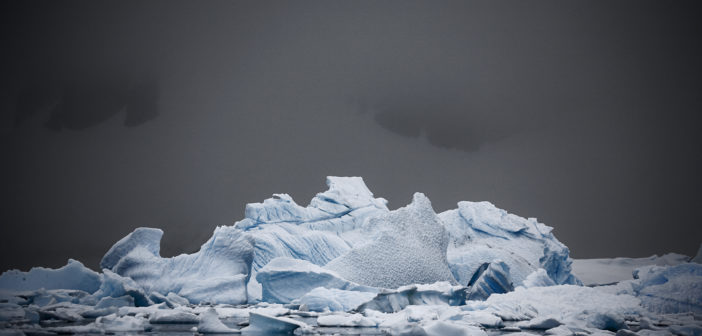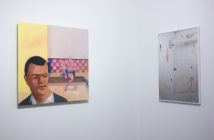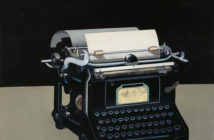Just as the last embankments of winter snow dissipated into rivulets in the corners of Brown University's campus, five mural-sized photographs of polar icescapes materialized on its prominent building facades. Installed in conjunction with the more traditional gallery exhibition, 33°, the murals range from the humorous, an image of tourists wandering aimlessly across an aqua blue expanse, to a sobering, a black fissure opening stark and deep in what we are to assume is an arctic ice sheet, to the iconic, a lonely polar bear drifting on a small iceberg.
The gallery exhibition and accompanying photomurals are comprised of the work of six artists: Olaf Otto Becker, Camille Seaman, James Balog, Jean de Pomereu, and Iain Brownlie Roy are all photographers while Jacob Kirkegaard works in sound. All six artists’ work focuses on the increasingly rapid melting of arctic and antarctic sea ice, with 33° Fahrenheit being the melting point of ice and the consequent environmental tipping point their works warn of.

Camille Seaman, Breaching Iceberg, Greenland, August 8, 2008. From Melting Away. Courtesy of the artist.
Behind framed images of the imposing water and wind carved landscapes of Seaman and Becker’s photographs, the whiteness of the gallery walls start to take on an almost chilly appearance, as if the standard color were an intentional part of the exhibition. The two photographers presented in the gallery (their work is also represent in the murals) are both veterans of polar photography, with Seaman having worked in both the artic and antartic regions and Becker working in Greenland.
While their subject matter may be similar, they each approach the landscape differently. Seaman sees her work as portraits of the icebergs with each image focused on a single floating behemoth. Her images are impacted by the fact that she is at sea, making her a part of their world as she floats amongst her subjects. This is perhaps why she feels such a familiarity with them. As a viewer it is harder to feel the same intimacy. There is a physical distance between Seaman and her subject and the images remain trapped as landscapes rather than as the portraits she describes them as by their mountainous likeness and horizontal composition.
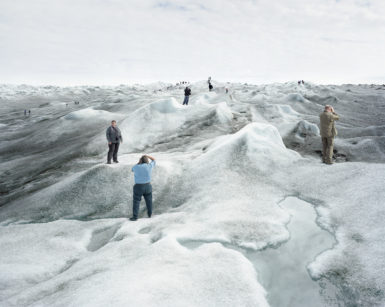
Olaf Otto Becker. Point 660, 2, 08/2008 67°09’04’’N, 50°01’58’’W, Altitude 360m. From Above Zero, Greenland, 2007¬–2008. Courtesy of the artist.
In contrast, Becker’s photographs of ice and water feel very different. He pointedly focuses his camera at how we are affecting the ice. Some images feel like blatant finger wagging such as rusting oil drums and other trash nestled and abandoned in a serene blue pool of glacial melt water or people posing awkwardly in lightweight jackets on a grubby icescape. Other images are more subtle, such as an image of an icy landscape that is more about the black dirt marring the perfect surface, slowly amassing as it is released from where it was once held within the ice, now increasing the melting speed of its former captor. Either more subtle, or possibly completely lacking in subtlety, are images that contain no ice at all, as if depicting what our future might look like.
Both artists’ images of our quickly diminishing polar ice are battling a culture that has become desensitized and complacent to images as presented in 33°. Even for someone whose personal interest lies at the intersection of art science, such as myself, can occasionally feel tired of being told climate change is a problem while directed to an image of a forlorn iceberg. Certainly the image of the polar bear on her thawing life raft is one that, although beautiful and haunting, made me initially roll my eyes. It’s only when I think about the number of near identical, but distinctly different, images I have seen over time that this icon’s initial spark of fear and fury is rekindled.
After reflecting upon many images of ice, rock, snow and sea, the gallery’s sound installation by Jacob Kirkegaard, is a curious oasis for reflection and rejuvenation. Once one has walked up the ramp and into the dark curtained enclosure which fills nearly half the gallery, it takes a moment for the eyes to adjust to the darkness and dim blue light. Although there is nothing to see, the piece feels as though it necessitates a walk around it. The sounds of shifting, creaking ice mingle with the persistent trickle of water, broken by the occasional distant and mysterious booming. From beneath the carpeted floor, the sound moves through the room, ricocheting, ebbing and flowing. The experience was disconcerting to the point where I felt literally imbalanced and had to pause to regain my balance and spatial awareness. It was oddly enjoyable and unsettling, like a sonic funhouse mirror. In this way the installation has more emotional impact than any of the icebergs presented in frames or hung from buildings. Kirkegaard’s installation is contextualized by the sculptural, blue and white forms in the photographs that surround it, but the sounds of the ice melting beneath one’s own feet makes climate change much more personal.
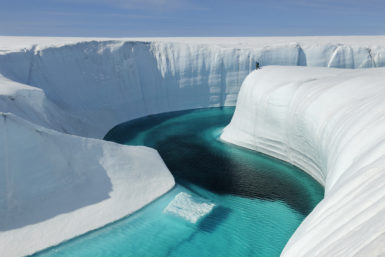
James Balog, Greenland Ice Sheet, 28 June 2009, Adam Le Winter surveys Birthday Canyon from ICE: Portraits of Vanishing Glaciers. Courtesy of the artist.
It can become disheartening to look at and listen too so many artworks of soon-to-be-gone landscapes, seascapes and animals. Even the quantity of the images seems like a lesson in,and critique on, how ambivalent or often ignorant our current culture seems to be about climate disruption. From the serene to the physically unsettling, 33° plays on an array of possible emotions surrounding a topic fraught with unnecessary tension and attempts to show an earnest view of our polar regions at this precarious moment.
33° is on view in the David Winton Bell Gallery through May 27th.

